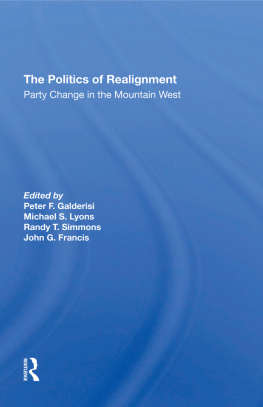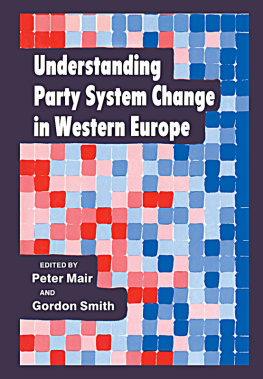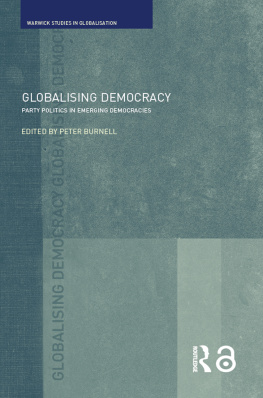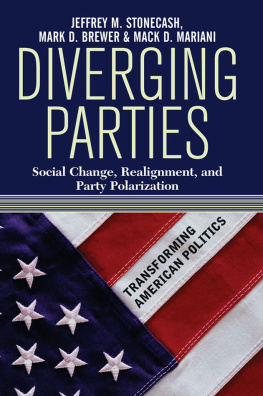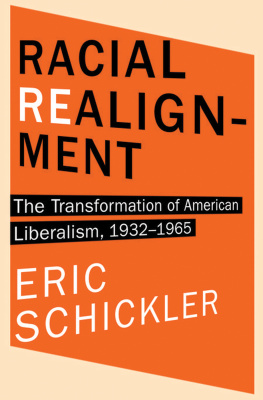The Politics of Realignment
About the Book and Editors
The landslide reelection of President Ronald Reagan in 1984 prompted political analysts to consider the possibility of a national realignment of the electorate toward the Republican party. The 1986 elections, however, proved any predictions of a national realignment to be premature. A major shift in voting patterns had not taken placeexcept in the Mountain West, where a realignment was already in place.
Once second only to the southern states in Democratic attachments, these western states (Arizona, Colorado, Idaho, Montana, Nevada, New Mexico, Utah, and Wyoming) now compose the most Republican region in the nation. The contributors to this volume assert that this substantial change in electoral patterns, which has spanned nearly forty years, resulted not from a westward migration but from a widespread conversion among those who are born and remain in the region.
In analyzing this realignment, these writerssome of the nation's best electoral scholarsprovide historical and contemporary overviews and assess the important issues not only for voters but also for party organizations and members of Congress. Their focus in The Politics of Realignment, however, is on the Mountain West's role in contemporary American politics. The authors present a comprehensive investigation into the meaning of this regional realignment for national politics.
Peter F. Galderisi (associate professor), Michael S. Lyons (assistant professor), and Randy T. Simmons (associate professor) are on the faculty of the political science department at Utah State University. John G. Francis is associate professor of political science at the University of Utah.
The Politics of Realignment
Party Change in the Mountain West
edited by
Peter F. Galderisi, Michael S. Lyons, Randy T. Simmons, and John G. Francis
First published 1987 by Westview Press
Published 2019 by Routledge
52 Vanderbilt Avenue, New York, NY 10017
2 Park Square, Milton Park, Abingdon, Oxon OX14 4RN
Routledge is an imprint of the Taylor & Francis Group, an informa business
Copyright 1987 by Taylor & Francis
All rights reserved. No part of this book may be reprinted or reproduced or utilised in any form or by any electronic, mechanical, or other means, now known or hereafter invented, including photocopying and recording, or in any information storage or retrieval system, without permission in writing from the publishers.
Notice:
Product or corporate names may be trademarks or registered trademarks, and are used only for identification and explanation without intent to infringe.
Library of Congress Cataloging-in-Publication Data
The politics of realignment.
1. Party affiliationWest (U.S.) 2. Political
partiesWest (U.S.) 3. West (U.S.)Politics and
government. I. Galderisi, Peter F. II. Lyons,
Michael S. III. Simmons, Randy T. IV. Francis, John
G., 1943-
JK2295.A17P65 1987 324'.0978 86-9086
ISBN 13: 978-0-367-29518-9 (hbk)
This volume is a project of the Utah State University Institute of Political Economy. Funding was provided by the Merrill Endowment, Utah State University and the University of Utah's Political Science Department. The editors are especially grateful to Candace Witmer Crist, Lori Jackman, Cindy Blockinger, Lee Ann Powers, and Barbara Hill for their assistance and tolerance, and to Sally Furgeson of Westview Press for her editorial guidance and patience.
Peter F. Galderisi
1
Realignment Past and Present
Peter F. Galderisi and Michael S. Lyons
With the landslide election and reelection of President Ronald Reagan, political analysts are once again discussing the possibility of a major electoral realignment, a realignment that would establish the Republicans as the national majority party. The evidence grows that such a realignment is in progress. Republicans won decisively in four of the last five presidential elections, all but the post-Watergate election of 1976. In 1980 they gained control of the U.S. Senate, holding it until 1986. They converted a Democratic stronghold, the South, into a highly competitive region. Their national party organization developed and disseminated modern campaign technology so effectively that even national Democratic leaders readily admit to Democratic inferiority in this area. In Gallup polls of voter party identification, which in the 1960s and 1970s typically suggested at least a 3 to 2 Democratic advantage, the Republicans now trail the Democrats only 38% to 33%. And the Republicans are clearly the majority among young voters entering the electorate.
But as compelling as the evidence of national realignment may appear to be, it is hardly conclusive. The residual strength of the Democratic party remains impressive: to paraphrase Mark Twain, the reports of its death are greatly exaggerated. According to the widely accepted critical elections theory, the realignment should have occurred in 1968 or 1972. Yet in 1986, despite the presidential landslides, despite Ronald Reagan's personal popularity, despite superior Republican campaign resources, despite the legacy of the troubled Carter presidency, and despite five consecutive divisive battles for the Democratic Presidential nomination, by most measures the Democrats continue to be the national majority party. The most conspicuous evidence of the continuing viability of the party is in U.S. House elections, won by Democrats 243-192 in 1980, 269-166 in 1982, 253-182 in 1984, and 260-175 (or thereabouts depending on recounts) in 1986. These elections have established since 1981 an average Democratic margin in the House of 256-179, almost precisely equal to the average Democratic margin of 258-177 from 1933 to 1970. The 1986 Democratic recapture of the U.S. Senate by a surprising 55-45 margin further indicates party support. Equally significant is the continuing Democratic domination of state governments, especially the legislatures. Gaining about 187 seats nationwide, Democrats emerged from the 1986 elections controlling 27 state legislatures compared to only 7 for Republicans. And despite a net loss of 7 races in 1986, Democratic governors remain a 26-24 majority.
Further complicating the realignment debate is the apparent detachment of many voters from either party, often called dealignment. One indication of dealignment is the growing proportion of self proclaimed independent voters. Since the 1950s, this proportion has increased from about 20% to about 35%, with as many as 42% claiming independent status in a September 1986 Time survey. A second indication is the strength of the third party presidential candidacies of George Wallace and John Anderson, especially the Wallace candidacy which at one point in 1968 had the support of over 20% of the electorate. The most impressive indication of dealignment, however, is the increased incidence of split ticket voting, which has more than doubled from a rate of less than 30% in the 1950s to more than 60% in recent elections (Ladd, 1982, p. 78).
Some analysts believe the current dealignment simply to be a transitory phase within a realignment, of longer duration perhaps, but otherwise similar to periods of instability associated with past realignments (Beck, 1974). Other analysts disagree (Burnham, 1975). They argue that issue voting, television, direct primaries, the advantages of incumbency, and other factors have permanently reduced the saliency of party identification in voting, making the whole concept of partisan alignment much less meaningful. To these analysts, as the columnist David Broder (1971) has suggested, "the party's over."


